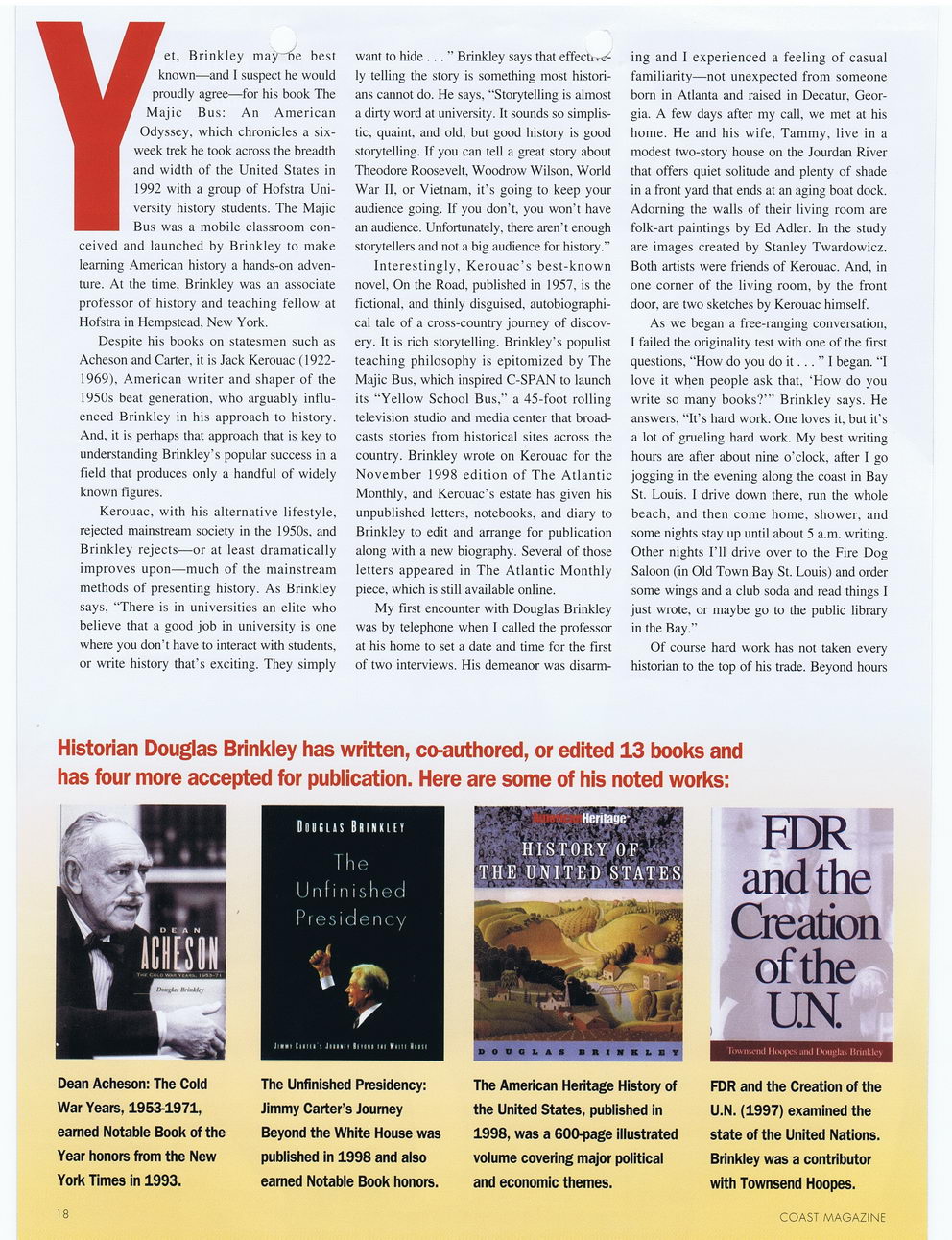This text was obtained via automated optical character recognition.
It has not been edited and may therefore contain several errors.
V^m et. Brinkley may~f>e best W known?and I suspect he would f proudly agree?for his book The Majic Bus: An American Odyssey, which chronicles a six-week trek he took across the breadth and width of the United States in 1992 with a group of Hofstra University history students. The Majic Bus was a mobile classroom conceived and launched by Brinkley to make learning American history a hands-on adventure. At the time, Brinkley was an associate professor of history and teaching fellow at Hofstra in Hempstead, New York. Despite his books on statesmen such as Acheson and Carter, it is Jack Kerouac (1922-1969), American writer and shaper of the 1950s beat generation, who arguably influenced Brinkley in his approach to history. And, it is perhaps that approach that is key to understanding Brinkley?s popular success in a field that produces only a handful of widely known figures. Kerouac, with his alternative lifestyle, rejected mainstream society in the 1950s, and Brinkley rejects?or at least dramatically improves upon?much of the mainstream methods of presenting history. As Brinkley says, ?There is in universities an elite who believe that a good job in university is one where you don?t have to interact with students, or write history that?s exciting. They simply want to hide ...? Brinkley says that effectively telling the story is something most historians cannot do. He says, ?Storytelling is almost a dirty word at university. It sounds so simplistic, quaint, and old, but good history is good storytelling. If you can tell a great story about Theodore Roosevelt, Woodrow Wilson, World War II, or Vietnam, it?s going to keep your audience going. If you don?t, you won?t have an audience. Unfortunately, there aren't enough storytellers and not a big audience for history.? Interestingly, Kerouac?s best-known novel, On the Road, published in 1957, is the fictional, and thinly disguised, autobiographical tale of a cross-country journey of discovery. It is rich storytelling. Brinkley?s populist teaching philosophy is epitomized by The Majic Bus, which inspired C-SPAN to launch its ?Yellow School Bus,? a 45-foot rolling television studio and media center that broadcasts stories from historical sites across the country. Brinkley wrote on Kerouac for the November 1998 edition of The Atlantic Monthly, and Kerouac?s estate has given his unpublished letters, notebooks, and diary to Brinkley to edit and arrange for publication along with a new biography. Several of those letters appeared in The Atlantic Monthly piece, which is still available online. My first encounter with Douglas Brinkley was by telephone when I called the professor at his home to set a date and time for the first of two interviews. His demeanor was disarm- ing and I experienced a feeling of casual familiarity?not unexpected from someone born in Atlanta and raised in Decatur. Georgia. A few days after my call, we met at his home. He and his wife, Tammy, live in a modest two-story house on the Jourdan River that offers quiet solitude and plenty of shade in a front yard that ends at an aging boat dock. Adorning the walls of their living room are folk-art paintings by Ed Adler. In the study are images created by Stanley Twardowicz. Both artists were friends of Kerouac. And, in one corner of the living room, by the front door, are two sketches by Kerouac himself. As we began a free-ranging conversation, I failed the originality test with one of the first questions, ?How do you do it...? I began. ?I love it when people ask that, ?How do you write so many books??? Brinkley says. He answers, ?It?s hard work. One loves it, but it?s a lot of grueling hard work. My best writing hours are after about nine o?clock, after I go jogging in the evening along the coast in Bay St. Louis. I drive down there, run the whole beach, and then come home, shower, and some nights stay up until about 5 a.m. writing. Other nights I?ll drive over to the Fire Dog Saloon (in Old Town Bay St. Louis) and order some wings and a club soda and read things I just wrote, or maybe go to the public library in the Bay.? Of course hard work has not taken every historian to the top of his trade. Beyond hours Historian Douglas Brinkley has written, co-authored, or edited 13 books and has four more accepted for publication. Here are some of his noted works: Dean Acheson: The Cold War Years, 1953-1971, earned Notable Book of the Year honors from the New York Times in 1993. Douglas Brinkley I he Unfinished Presidency JllHl tllMl?l JlHlfl IlHII III VlIM llltl The Unfinished Presidency: Jimmy Carter?s Journey Beyond the White House was published in 1998 and also earned Notable Book honors. The American Heritage History of the United States, published in 1998, was a 600-page illustrated volume covering major political and economic themes. FDR and the Creation of the UN limnscnd H?h>jx:s and i>oui?);is Hrinkk*) FDR and the Creation of the U.N. (1997) examined the state of the United Nations. Brinkley was a contributor with Townsend Hoopes. COAST MAGAZINE

Brinkley, Douglas Coast-004